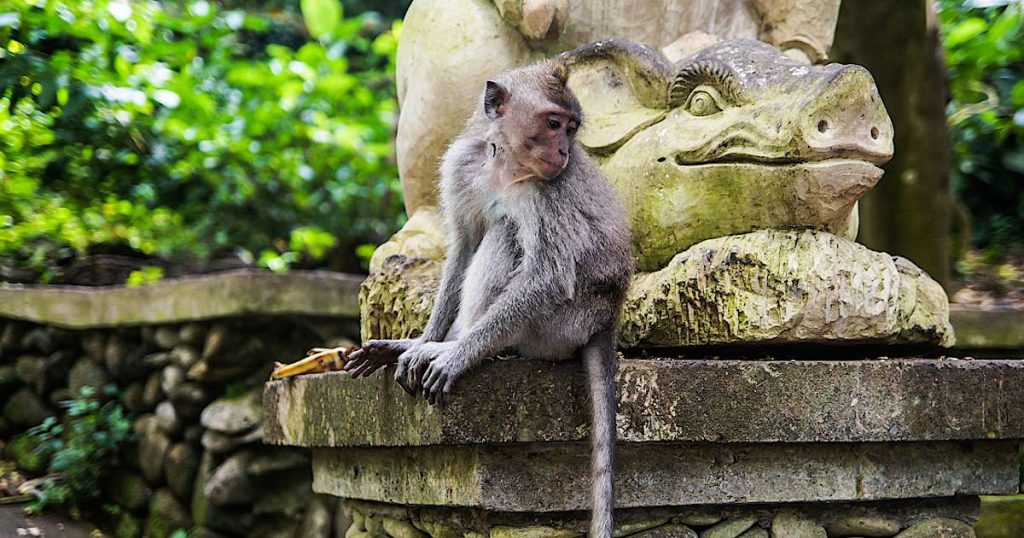Bali’s tropical climate and abundant vegetation provide the perfect environment for a variety of fauna. In the streets, parks, jungles and even next to apartment complexes, you’ll find amazing creatures. Animals of Bali are not only macaques and bats, but also exotic species: musangs, geckos, Bengal cats, as well as a variety of insects and reptiles. The diversity of nature makes the island unique. And its inhabitants sometimes surprise even experienced travellers.
Diversity of island inhabitants
The island’s location and mild climate contribute to the richness of its fauna. Bali’s fauna is represented by several main groups: mammals, birds, reptiles, insects and marine life. Here you can find both typical Southeast Asian animals and unique animals found nowhere else.
Mammals include flying foxes, muskrats, wild dogs and even Bengal cats. Birds include exotic birds of paradise, starlings, storks and rare parrots. Reptiles include geckos, snakes and large varans. And the sheer number of insects makes the island a paradise for entomologists.

Bali’s animals are diverse and observing them becomes one of the unforgettable experiences for travellers. Thanks to the preservation of nature reserves, many species feel comfortable even near human settlements.
Monkeys in Bali: clever, cunning and very cheeky
 Macaques are often seen in the streets and temples of the island. These animals have long been accustomed to tourists and know they can get food. They can be found in the monkey forest in Ubud, at Uluwatu Temple and even on some beaches.
Macaques are often seen in the streets and temples of the island. These animals have long been accustomed to tourists and know they can get food. They can be found in the monkey forest in Ubud, at Uluwatu Temple and even on some beaches.
These primates are characterised by their intelligence, cleverness and, at the same time, recklessness. Macaques are not afraid of people and easily steal glasses, phones and other small items from tourists. They are interesting to watch, but it is important to remember: it is better not to provoke their aggression.
Tips when encountering macaques:
- Do not attempt to pet or feed animals from your hands;
- keep bags and pockets closed;
- not making eye contact with a monkey is considered a challenge.
Despite their cunning and cheekiness, macaws remain one of the symbols of the island and their presence makes the resort even more colourful.
Geckos: the nocturnal singers of Balinese homes
The presence of geckos in the house is a sign of good luck. These animals are considered good spirits in Bali, protecting the house from insects. They hide in crevices during the day and come out at night to hunt, making characteristic clicking sounds.
Geckos are not dangerous to humans. Moreover, they fulfil an important function in the ecosystem: they destroy mosquitoes and other harmful insects. Their presence in hotels and villas is a normal phenomenon that should be treated calmly.
Spiders, ants and other small creatures
Among the animals of Bali, spiders and ants have a special place. Most spiders in Bali are safe, but there are some poisonous species. Tourists should avoid touching them, especially in the jungle.
Ants are an integral part of the local fauna. They can be found everywhere: in houses, on beaches and in restaurants. They react quickly to sweets and food residues, so it is important to keep clean.
Bali’s unique animals
Among Bali’s most unusual animals, Musangs and Bengal cats stand out. Musangs are known for producing luwak coffee, the most expensive coffee in the world. These nocturnal predators feed on fruit and insects, and their unique ability to digest coffee beans makes them important players in the coffee business.
Bengal cats are exotic pets that can sometimes be found on the island. These graceful predators are prized for their beauty and intelligence.
Bali’s dangerous and safe animals: who to be afraid of
Bali’s tropical climate attracts not only tourists, but also many animals. Among them there are poisonous and completely safe species. Understanding what you might encounter on the island will help travellers avoid unpleasant situations.
Dangerous Animals of Bali
Among the most dangerous animals on the island are snakes, scorpions and some species of spiders. In the dense jungles and rice paddies you can find poisonous snakes: the krait or Russell’s viper. These reptiles prefer to hide in the grass or under snags, so caution is advised when walking in the wild.
Scorpions are found in rainforests and can crawl into living spaces. Their venom causes painful sensations, but fatalities are extremely rare. Spiders, including black widows, are not as common, but their stings can be dangerous for people with allergies.

To avoid unpleasant encounters with dangerous fauna, it is recommended:
- Inspect shoes and clothing before putting them on.
- Do not stick your hands in cracks and crevices.
- Use a torch when walking at night.
- Wear closed toed shoes in wooded areas.
Safe Animals of Bali
Most of Bali’s animals are completely harmless to humans. These include many mammals, reptiles and birds. For example, geckos are not only safe but also beneficial – they feed on insects and mosquitoes, helping to control their numbers. Flying foxes, often seen in the sky after sunset, feed on fruit and are not a threat.
A variety of exotic birds, such as the Balinese starling, make the island’s nature even more unique. These birds are adaptable to human neighbourhoods and can even be found in city parks.
Understanding the differences between dangerous and safe wildlife allows you to enjoy your stay in Bali without fear of wildlife.
Conclusion
 Bali’s animals make the island truly distinctive. Encounters with them can be both pleasant and unexpected. From monkey sightings at temples to evening gecko ‘concerts’, the island offers a special interaction with nature. It’s important to remember: animals here are an integral part of the ecosystem, and treating them with respect preserves this fascinating world.
Bali’s animals make the island truly distinctive. Encounters with them can be both pleasant and unexpected. From monkey sightings at temples to evening gecko ‘concerts’, the island offers a special interaction with nature. It’s important to remember: animals here are an integral part of the ecosystem, and treating them with respect preserves this fascinating world.
 en
en  ar
ar  de
de  es
es  fr
fr  nl
nl  ru
ru  hi
hi  it
it  pt
pt  el
el 











